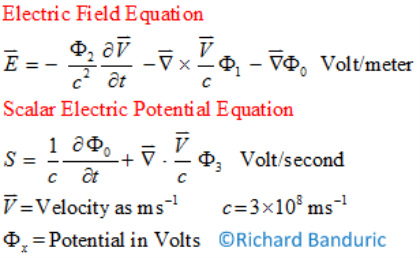Propellant-less spacecraft propulsion Systems
Introducing an all new PATENTED method of spacecraft propulsion that is based on the interaction of motional electric fields against static electric fields. This new method generates propulsion from the interaction of motional electric fields from moving charged high resistance elements against the static electric fields of charged conductive elements. These motional electric fields were originally hinted at in James Maxwell's original bi-quaternion derivation that unified the electric and magnetic field as extra terms. The extra terms were predicted to be real and theorized to be the result of a new scalar field in an article in the Hadronic Journal 24 ( 2001) 609-628 "Generalization of Classical Electrodynamics to Admit a Scalar Field and Longitudinal Waves" by Koen J. van Vlaenderen and André Waser and in the paper "A generalisation of classical electrodynamics for the prediction of scalar field effects" by Koen J. van Vlaenderen. The derivation that was done in the Hardonic Journal was re-derived by us to support the theory of Lorentz-Fitzgerald contraction observed from the charge density of a moving charged element or an electric convection current. This was done by converting the potentials from Weber/Meter in the original derivation to Volts to give us a new electric field and scalar electric potential equations shown below:

The derivation of these equations is done in the "The Math" tab on this website. This derivation is expanded on in the publication "New Electrodynamics" that is available from the buttons at the end of this page. This derivation is also expanded on in the US Patent Application 20140009098 "INTERACTING COMPLEX ELECTRIC FIELDS AND STATIC ELECTRIC FIELDS TO EFFECT MOTION". The motional electric fields that are implied by these equations were easy to replicate if a simple set of rules are followed. The effects from these equations are not seen with electrical conduction currents. They are only seen with electrical convection currents. The effects from Scalar Electric Potential were also observed as an electric field from a decoupled potential that supports the idea that a new scalar field exists.
The motional electric fields predicted by these equations were measured and characterized by a number of different experiments using moving charged elements. Some of these experiments are described in the "The Experiments" tab including the resulting data.
The surprising results from these experiments were that a number of techniques were discovered that would geometrically amplify these motional electric field changes. A number of different geometries of the charge holding elements were also shown to amplify the relativistic electric field changes. In a number of cases the amplification of relativistic electric fields by a factor of 10,000 or higher were achieved.
The results from these equations and experiments clearly showed that charged elements in relative motion would have different total electrical fields depending on the inertial frame of reference that the charged element was viewed from. This allowed us to create an assembly of two different charged elements in two different inertial frames of reference that would experience an axial force or thrust from the interaction of one of the elements static electric field and other element's relativistic electric field. This is the breakthrough that has allowed us to develop the next generation of propellant-less propulsion system.
The following pages on this website documents the development of this technology all the way from the theory to the basic design of one device that generates propellant-less thrust. The supporting documentation and the documentation that elaborates on the basic information contained on this website is also available below.
-Richard Banduric
rbanduric@electricspacecraft.org
The surprising results from these experiments were that a number of techniques were discovered that would geometrically amplify these motional electric field changes. A number of different geometries of the charge holding elements were also shown to amplify the relativistic electric field changes. In a number of cases the amplification of relativistic electric fields by a factor of 10,000 or higher were achieved.
The results from these equations and experiments clearly showed that charged elements in relative motion would have different total electrical fields depending on the inertial frame of reference that the charged element was viewed from. This allowed us to create an assembly of two different charged elements in two different inertial frames of reference that would experience an axial force or thrust from the interaction of one of the elements static electric field and other element's relativistic electric field. This is the breakthrough that has allowed us to develop the next generation of propellant-less propulsion system.
The following pages on this website documents the development of this technology all the way from the theory to the basic design of one device that generates propellant-less thrust. The supporting documentation and the documentation that elaborates on the basic information contained on this website is also available below.
-Richard Banduric
rbanduric@electricspacecraft.org
Technical Documentation Resources
|
|
| ||||||||||||||||||||||||||||||